
About MotoGP
MotoGP was established as a World Championship by the FIM (Fédération Internationale de Motocyclisme) in 1949. It is the oldest motorsports championship in the world and consists of three racing classes that take to the track on a Grand Prix weekend.
This is a premier motorcycle world championship where world’s most skilled riders equipped with motorcycles featuring cutting-edge motorcycle technology.
This sport has a rich history, started with ‘500cc’, the championship, the mode of championship changed in 2002 and with new regulations introduction of four-stroke machinery with increasing in the engine capacity to 990cc thus becoming MotoGP.
MotoGP rules were altered in 2007 that limited the capacity of the engine to 800cc. The rules were again changed to include upto1000cc in 2012. MotoGP Championship has been administered by commercial rights owners Dorna Sports under the supervision of FIM since 1992.
With the sport gaining huge popularity world over, two more World Championship Grand Prix categories were introduced. These categories have their individual race during each Grand Prix. The Moto3 (formerly 125cc) and Moto2 (formerly 250cc) World Champions along with MotoGP World Champion are crowned after every season.
Skilled riders from all over the world belonging to many nationalities along with manufacturers like Aprilia, Ducati, Honda, Suzuki, Yamaha and KTM takes part in this highly competitive sports. This is also a sport where many technologies like tyres, engines, brakes and aerodynamics along with riders skills are put to the ultimate test.
For the latest standings in MotoGP refer: MotoGP
Objective
MotoGP or Moto Grand Prix, Grand Prix is a French word meaning great prize, is a team event, though it may seem apparent that it is the rider who drives the bike. The rider is an important member of the team, but there are many engineers and support staffs involved in this sporting event.
This sport is played according to a pre-determined schedule, spanning across multiple countries. The MotoGP season starts around the middle of March every year and ends around the middle of November.
The race events take places in race circuits specially designed for testing the rider’s control, ability and handling of the bikes. These race circuits are also a test for the bike’s endurance and manoeuvrability.
The racing circuit has bends of different circumference as well as straight line that tests both the bikes straight-line speed and braking manoeuvrability along with riders’ skills.
The rider who crosses the finish line first after completing a pre-determined number of laps of a circuit is declared the winner of the race. Rider and team are awarded certain points based on the position of the bike after finishing of each race.
At the end of the racing season, the rider who has acquired the maximum number of points accumulated throughout the racing year is declared as the Driver champion. Likewise, the team that has acquired the maximum number of points accumulated throughout the racing year is declared the Constructors champion.
Divided into three different categories Moto3 (formerly 125cc) and Moto2 (formerly 250cc) along with MotoGP, after the end of each season, Driver champion and Constructors champion is declared from each category.
Awareness
MotoGP is an expensive motorsport event that requires the most advanced technology for bikes. So a lot of funds is invested in research and development of design, engine, fuel efficiency, braking etc.
The objective is to make the bikes lighter and smooth aerodynamically with an engine that can deliver the maximum thrust and can brake hard along with easy manoeuvrability.
The bikes itself is expensive having thousands of parts. Logistics and moving these many parts along with the bikes to distance places throughout the year along with the staff also bears a heavy cost.
Several teams participate in MotoGP under various categories. A maximum of 3 riders from each team can participate in the race; some of the teams have only 1 rider while some teams may have up to 3 riders.
A team of engineers, mechanics, team director, the technical director usually called the support staff are associated with every participating team that plays a vital role in the team’s success.
The minimum race distance is of 95 kilometres (59 miles) and a maximum is that of 130 kilometres (81 miles) per race. The race circuit is designed in such a way to test the endurance, handling and manoeuvrability of the bike and the rider riding it. There are many curves and hairpin bends and the straight-line road to test the performance of the bike.
The Race Bikes
MotoGP race bikes are single-seat bikes that may have no more than six gears with no super or turbocharging. Each rider in MotoGP has two bikes prepared to race by the team.
For Moto2 and Moto3 there may be only one bike per rider. These bikes are all one-of-a-kind prototypes, using the latest technology available in the motorcycle industry every bike is hand-built.
Each bike also have around 30 to 40 sensors that gather data, such as suspension travel, brake and exhaust temperature and steering angle etc.
The racing bikes use race-specific components that are also put under extreme conditions during racing, many of these parts may last only a few hours.
- MotoGP race bikes are up to 1000cc weighing up to 157 kg and have a maximum speed of around 350 km/h and generating power of about 250 hp.
- Moto2 race bikes are up to 765cc generating power of 138hp and have a maximum speed of around 300 km/h. The maximum weight of a bike and the rider must not exceed 215 kg.
- Moto3 race bikes are 250cc single-cylinder four-stroke engines having a maximum bore of 81mm and have a maximum speed of around 250 km/h. The maximum weight of a bike and the rider should not exceed 152 kg. The minimum age for this class normally is 16 years, and cannot be older than 28 years, or 25 years for new contracted riders participating for the first time and wild-cards.
The teams may add ballast to their bikes to achieve the minimum weights.
Safety
MotoGP is high-speed motorsport, hence safety of riders and spectators is of utmost priority. FIM has its official safety regulations and any violations are penalized heavily.
This sport has seen many casualties due to the lack of enhanced safety measures. In total, about one-hundred-and-three riders have died from incidents that occurred at a Grand Prix motorcycle racing event, with Ben Drinkwater being the first in 1949.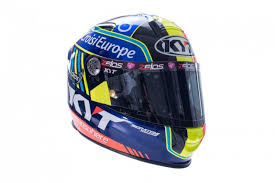 Crash Helmets: Head and neck injuries remain the greatest single injury risk to the rider. A rider’s head is subjected to extreme G-forces experienced during accelerating and braking with high speed. Crash helmets are compulsory in MotoGP.
Crash Helmets: Head and neck injuries remain the greatest single injury risk to the rider. A rider’s head is subjected to extreme G-forces experienced during accelerating and braking with high speed. Crash helmets are compulsory in MotoGP.
A modern helmet is very light and is very strong. The stronger the helmet, the greater is its ability to absorb impacts and resist penetration during a crash. They are mainly made up of carbon fibre, polyethylene and fire-resistant aramide, and are constructed in several layers.
The helmet’s visor is also made up of fire-resistant polycarbonate providing excellent visibility. Riders use tinted visors that are coated with anti-fogging chemicals that prevent the accumulation of mist during rain.
Several transparent strips are attached outside the visor that rider can peel off to clear their vision to remove the dirt accumulating in the visor during the race.
Adequate and filtered ventilation is also provided in the helmet for breathing. The helmets are aerodynamically designed to minimize drag.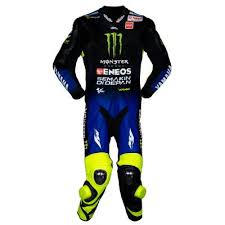
Clothing: Riders suit is made up of fire-resistant, lightweight artificial fibre. It can withstand high temperature. These suits are also worn by pit crews.
Under the helmet, riders wear a balaclava made of the same material. Under the suit, the rider also wears flameproof underwear. Boots are made of soft, cushioned leather is also fire-resistant; the gloves are also fire-resistant and made up of the same artificial fibre.
Rider also wears a biometric glove during riding the bike. The clothing has an airbag that inflates during any impact thus protecting the rider.
About the Race
MotoGP race takes place according to a pre-determined schedule, over a weekend. It takes place through a period of 3 days Friday, Saturday and Sunday. Practice sessions Q1 and Q2 are separately held for each category Moto3, Moto2 and MotoGP.
Practice Session: On Friday morning and afternoon, and Saturday morning, three 45-minute Free Practice sessions. The times set by the riders counts and the results determine whether a rider will participate in Q1 or Q2.
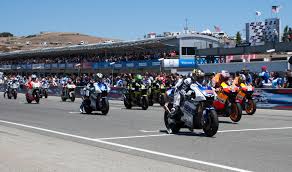
Q1: The riders who have clocked timings 11th place and below participate in Q1, which is a 15 min session. The riders have the luxury to qualify for Q2. Two of the fastest riders from this session can participate in Q1.
Q2: The first 10 riders along with two riders of Q1 contest in the Q2 session. The rider finishing the fastest amongst them all is awarded the pole position, which is the first position of the grid.
Other riders take up the positions based on their timings to determine the starting order of the grid. The riders of Q1 takes up grid positions 13 and below according to their placement in Q1.
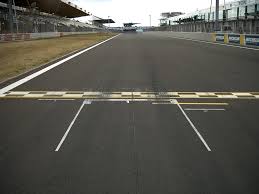 Race: MotoGP race takes place on Sunday afternoon. The race starts with the smallest category, Moto3. After completion of the race and distribution of prizes, the Moto2 machines take up the grid. And finally, after completion of this race and distribution of prizes, the MotoGP machines take up the grid for the final race.
Race: MotoGP race takes place on Sunday afternoon. The race starts with the smallest category, Moto3. After completion of the race and distribution of prizes, the Moto2 machines take up the grid. And finally, after completion of this race and distribution of prizes, the MotoGP machines take up the grid for the final race.
The race of each category starts with a warm-up lap, during which the riders drive their bikes along the race track in slow speed to ensure that track conditions are safe and handling of the bikes is smooth.
This lap is also used to build up tyre temperatures. Once all the bikes have taken their respective positions on the grid with their engines running, the race begins with the five pairs of lights turning green one after another after one sec. When all five pairs of lights turn green the race begins.
Race Officials
- Race Director: Responsible for ensuring proper observance of the Regulations and efficient running of the practice and races. The Race Director is also responsible for all communications between the Event Management Committee and the FIM MotoGP Stewards Panel.
- The Clerk of the Course: Always work in permanent consultation with the Race Director. He ensures that the circuit is suitably prepared and maintained during the event and that all legal requirements applicable for the running of the event have been met along with adherence to the timetable. The control of practice and the race, adherence to the timetable Ensuring that the circuit is suitably prepared for and maintained during the Event.
- Deputy Race Director: Responsible for all duties of the Race Director if the Race Director is unavailable.
- Technical Director: Responsible for ensuring that technical Regulations are correctly enforced and supervising scrutinizing and protests of a technical nature.
- Medical Director: Responsible for liaison with the Chief Medical Officer who is appointed by the promoter to ensure compliance with the Medical Code.
- FIM Safety Officer: Responsible for the supervision of all aspects of safety.
- Starter: Responsible for the start procedure of the race.
- Other Officials: Includes Marshals posted at various posts throughout the race circuit, Technical Scrutinizers, Security Personnel, Medical personnel.
Some Rules of the Race
- For competing in the Championship, riders must be officially entered by a member team of IRTA. The rider must own an “FIM Grand Prix License” issued by an FMN. Riders are designated by IRTA/Grand Prix Commission. Licenses can, in certain circumstances, be for a single event. The constructors must own the appropriate “FIM Manufacturer License”.
- Age limitations
- MotoGP: Minimum age is 18 years and the maximum age is 50 years.
- Moto2: Minimum age is 16 years and the maximum age is 50 years.
- Moto3: Minimum age is 16 years and the maximum age of 28 years.
- To be classified as a Rookie, a rider must not have competed in six or more events, in the same class, in any one previous season.
- A team may choose to substitute another rider for the withdrawn rider, with the deadline for substitution of the entered rider being two hours after the end of the Free Practice 2 session for that class, except in the MotoGP class when the limit is 2 hours before the qualifying practice.
- In Moto2 Wild Card entries are not available. There may be a maximum of two MotoGP wild card entries per event. Wild card riders must be holders of an FIM “one event Grand Prix” license issued on behalf of any FMN.
- A rider is deemed to have taken part in the event when he participates in, at least, one practice session. A rider is deemed to have started a race when he participates in, at least, the first lap of the race.
- In the MotoGP class, Motorcycle Manufacturers are permitted to participate with a maximum of two entries in their team. Some manufacturers may also lease motorcycles and equipment to Independent teams. Each Manufacturer is permitted a maximum of 3 Wild Card entries per season. A Manufacturer is not permitted to have Wild Card entries at consecutive events.
- Teams in the MotoGP class may present a maximum of two motorcycles per rider. In the Moto2 and Moto3 classes, teams may present only one motorcycle per rider for Technical Control.
- Test riders are permitted only for Motorcycle Manufacturers with their factory team.
- 120 tyres are allocated for a contracted rider per season. These tyres may be used by a test rider or the team’s contracted riders only.
- Riders start practice from the pit lane when the green light is displayed at the exit of the pit lane.
- The duration of practice starts with the illumination of the green light. A count-down displays on the official Timekeeping monitors to indicate the minutes of practice remaining.
- The end of practice is indicated by the waving of a checkered flag during which the pit exit is closed. A rider’s time continues to be recorded until he passes the finish line after the allotted time has elapsed.
- If the practice is interrupted due to an incident or any other reason, then a red flag is waved at the start line and in all marshals posts. All riders must return slowly to the pit lane. When practice is restarted, the time remaining is displayed on the monitors of the official timekeepers.
- After practice sessions start, it is not permitted for any person to alter the condition of the racing surface of the circuit. This includes track Marshals and other Officials, who cannot clean the track surface without prior instructions.
- In the MotoGP class, a rider may practice on two motorcycles providing that these motorcycles have been scrutinized. In the Moto2 and Moto3 classes, a rider may practice on the one motorcycle that has been scrutinized in the name of his/her team.
- Moto2 and Moto3 class rider may change to another motorcycle only in the case of irreparable damage to the principal machine, and only with the permission of the Technical Director who authorizes the issue of a new scrutinizing sticker to identify the new machine.
- To participate in qualifying practice a rider must have achieves a lap time at least equal to 107% of the time recorded by the fastest rider in the same session, in any one of the three Free Practice sessions.
- The pole position is allocated to the fastest rider, for all classes, the Grid is arranged in the “in echelon” 3-3-3-3 configuration.
- In the case of a rider starting the race from pit lane (due to a penalty), the final grid will show the rider in last position and riders qualifying behind that rider moves up, to fill that vacant position. The rider makes the sighting lap and takes the last place on the grid, then enter the pit lane at the end of the warm-up lap, to start the race from pit lane.
- MotoGP riders who make weather-related tyre changes after the pit lane exit has closed will start the warm-up lap from pit lane. However, they take their qualifying grid position but serve a ride through penalty within the first 5 laps of the race. Therefore riders still in pit lane must make a tyre choice (rain or slick) before the pit lane exit has closed.
- For each class the declaration of a Wet Race is made as early as possible, in principle before the pit lane opens for the sighting lap, to assist the teams in planning.
- Refuelling or changing fuel tank on the grid is forbidden for all classes.
- Three minutes before the start of the Warm-Up Lap, The riders must put their helmets on. Immediate removal of tyre warmers from machines on the grid applies 1 minute before the start of the Warm-Up Lap. At this point, all team personnel except the mechanics leave the grid.
- Thirty seconds before the start of the Warm-Up Lap, all the riders must be in position on the grid with engines running. No further assistance from mechanics is permitted. A Green Flag is waved to start the Warm-Up lap.
- Any rider who is unable to start his machine must remove it to the pit lane, with the help of grid marshals, where further attempts can be made to start it the bike. Such riders may start the Warm-Up lap from the pit lane and start the race from the back of the grid, provided they exit before the pit lane is closed and reach the grid before the Safety Car.
- If they do not exit before the pit lane is closed, they will start the race from pit lane. Attempting to restart the motorcycle on the grid is not permitted.
- The riders make one lap at unrestricted speed, followed by a safety car. On returning to the grid the riders must take up their positions with the front tyre not touching the track surface of the painted grid lines. When each row of the grid is completed, the officials lower the panels indicating that their row is complete.
- The panel of the grid row is not lowered when a rider in that row has indicated that he has stalled his motorcycle or having other difficulties. When all panels of the grid are lowered and the safety car has taken up its position, an official at the rear of the grid waves a green flag.
- The Starter instructs the official at the front of the grid, displaying the red flag, to walk to the side of the track. A red light is displayed for between 2 to 5 seconds. The red light goes out to start the race. The safety car follows behind the motorcycles for the whole of the first lap.
- Rider attracts penalty for jumping red lights in anticipating the start of the race. In case of a delayed start, the “Start Delayed” board is displayed from the Starter’s marshal’s waves yellow flags at each row of the starting grid from the signalling platform. Riders should stay in their grid position with helmets on, but engines may be switched off.
- The location of the rider’s pit box is indicated by signs in pit lane and it is forbidden for team members to be positioned in front of pit lane to signal the pit box position to the rider.
- When a race is stopped, riders return to the pit lane. Upon arrival in the pit lane, repairs and adjustments may be made to the motorcycle and refuelling is permitted. The time remaining to the opening of the pit exit gets displayed on timing screens and countdown boards.
- When the time has elapsed, the pit lane exit will be opened for SIXTY SECONDS only. Riders make one lap at unrestricted speed to the starting grid, followed by a Safety Car. Any riders remaining in the pit lane after it has been closed will have to start the Warm-Up lap from the pit exit and start the race from the back of the grid.
- In case of a drive-through penalty imposed on the driver due to jump-start or other infringements. The rider will be requested to ride through the pit lane. Stopping is not permitted. A speed limit of 60 km/h is enforced in the pit lane at all times during the event.
- Riders must respect the speed limit from where the sign 60 km/h is placed up to where the sign 60 km/h crossed out is placed. In case of infraction of this speed limit, the ride through procedure will be repeated; in case of a second infraction of this speed limit, the black flag will be shown to the rider.
- All races are categorised as either wet or dry. A board is displayed on the grid to indicate the status of the race. If no board is displayed, the race is automatically dry. The purpose of this classification is to indicate to riders the consequence of varying climatic conditions during a race.
- Riders must obey the flag signals, the light signals, and the boards which convey instructions. Riders must ride in a responsible manner which does not cause danger to other competitors or participants, either on the track or in the pit lane. Any infringement of this rule is penalised by Stewards.
- In case a rider falls off from his bike, the marshals may assist the rider to the extent of helping him to lift the machine and holding it whilst any repairs or adjustments are made. The rider may then be assisted by marshals or others to re-start by pushing or to move the machine on track, trackside or in the service road. No person other than marshals or riders is permitted on the trackside of the first line of protection.
- If the rider intends to retire, then he must park his motorcycle in a safe area as indicated by the marshals. If the rider encounters a problem with the machine which will result in his retirement from the practice or the race, then he must not attempt to tour at reduced speed to the pits but rather pull off from the track and park his machine in a safe place or as indicated by the marshals.
- Riders may enter the pits during the race, but taking the motorcycle inside the pit box is not permitted unless the driver retires from the race.
- Stopping on the track during practices and races is forbidden. All machines are required to carry an onboard camera(s).
Safety Car
MotoGP is a risky sport. The safety car is an integral part of MotoGP.
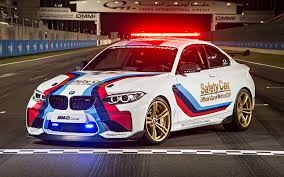
In every Grand Prix, Carlos Ezpeleta is in charge of driving the safety car. The safety car driver is in permanent radio contact with race control.
Two medical cars omega1 and omega2 form part of the Dorna-sponsored medical team during the Championship.
Racing Flags
Flags play an important role in visually communicating messages quickly and efficiently to the race riders. Although the radio could theoretically perform the same task, flags are much easier to use to communicate these certain universal messages to the riders like the race start or finish, lap indication, bad weather indication, etc.
Race Marshal raises the flags to alert the rider of the upcoming dangers so that they can take proper action. Though some race tracks employ lights to supplement the flags.
![]() Checkered Flag: A checkered flag is waved indicating the end of race. The race leader is shown the checkered flag at the end the race. The checkered flag is also waved at the end of the allotted time during practice and qualifying sessions which indicates the end of the session.
Checkered Flag: A checkered flag is waved indicating the end of race. The race leader is shown the checkered flag at the end the race. The checkered flag is also waved at the end of the allotted time during practice and qualifying sessions which indicates the end of the session.
![]() Yellow Flag: This flag warns riders about the danger ahead beside the track. During then yellow flag period, overtaking is prohibited.
Yellow Flag: This flag warns riders about the danger ahead beside the track. During then yellow flag period, overtaking is prohibited.![]()
Green Flag: This flag gives an all-clear signal to the rider and continues with racing. It also indicates that the potential danger has been removed.![]() Red Flag: The race or the session is being interrupted due to some accident or poor track conditions. Riders must return slowly to the pits.
Red Flag: The race or the session is being interrupted due to some accident or poor track conditions. Riders must return slowly to the pits.![]() Blue Flag: This flag is an indication that the rider is about to be overtaken by a faster rider which is ahead of bikes current position. Rider must make way for the faster car to overtake him. Overlooking 3 blue flags, rider risks to be penalized.
Blue Flag: This flag is an indication that the rider is about to be overtaken by a faster rider which is ahead of bikes current position. Rider must make way for the faster car to overtake him. Overlooking 3 blue flags, rider risks to be penalized.![]() Yellow And Red Striped Flag: The track surface is slippery due to oil spill or water.
Yellow And Red Striped Flag: The track surface is slippery due to oil spill or water.![]() Black With Orange Circle Flag: This flag warns a rider that he has a mechanical problem and must return to his pit.
Black With Orange Circle Flag: This flag warns a rider that he has a mechanical problem and must return to his pit.![]() Black Flag: This flag is used as a signal to the rider that he has been excluded from the race, and that the rider should immediately return to his pit.
Black Flag: This flag is used as a signal to the rider that he has been excluded from the race, and that the rider should immediately return to his pit.![]() White Flag With Diagonal Red Cross: This flag is used to warn riders about the drops of rain on this section of the track. Together with Yellow and Red striped flag warns the driver about rain in a particular section of the track.
White Flag With Diagonal Red Cross: This flag is used to warn riders about the drops of rain on this section of the track. Together with Yellow and Red striped flag warns the driver about rain in a particular section of the track.![]() White Flag: Waved at the flag marshal post during the race, this flag indicates that the riders are allowed to change machine.
White Flag: Waved at the flag marshal post during the race, this flag indicates that the riders are allowed to change machine.
Race Points
MotoGP uses a points system to determine the outcome of both the Riders’ and Constructors’ World Championships. The Championships are awarded to both the rider and the team that has scored the largest number of points over the Championship season. To receive points, a driver must be classified as a finisher.
The driver must have completed at least 75% of the distance covered by the winner, and cross the finish line on the race track (not in the pit lane) within five minutes of the race winner. In this point system, the top 15 riders are awarded points in each race.
- 25 Points.
- 20 Points.
- 16 Points.
- 13 Points.
- 11 Points.
- 10 Points.
- 9 Points.
- 8 Points.
- 7 Points.
- 6 Points.
- 5 Points.
- 4 Points.
- 3 Points.
- 2 Points.
- 1 Points.
Some Race Circuits
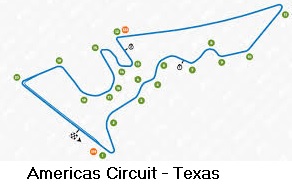
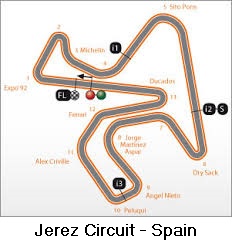
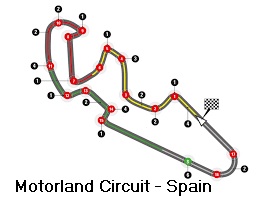
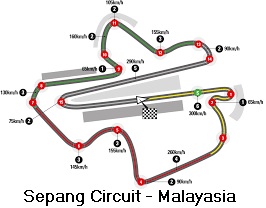
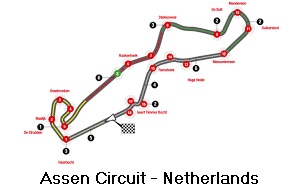
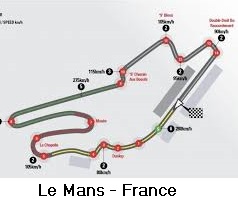
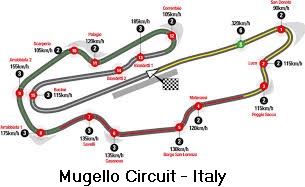
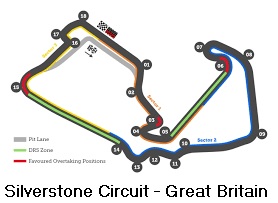
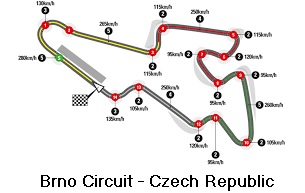
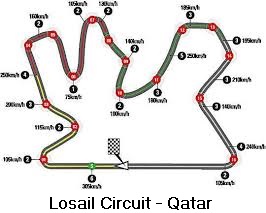
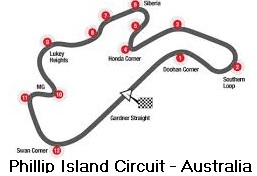
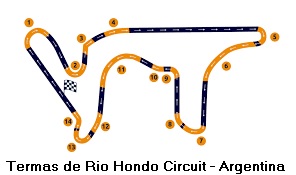
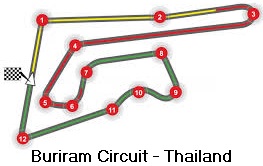
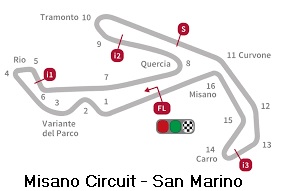
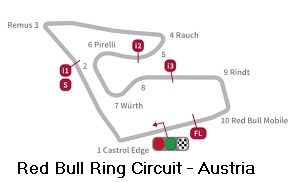
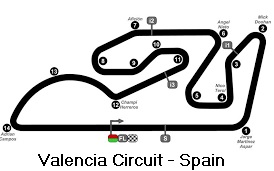
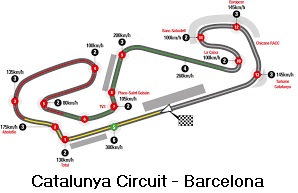
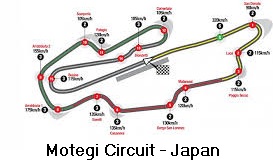
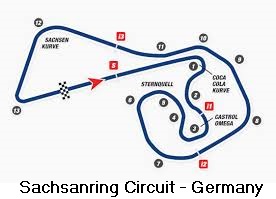




 (8 votes, average: 5.00 out of 5)
(8 votes, average: 5.00 out of 5)


